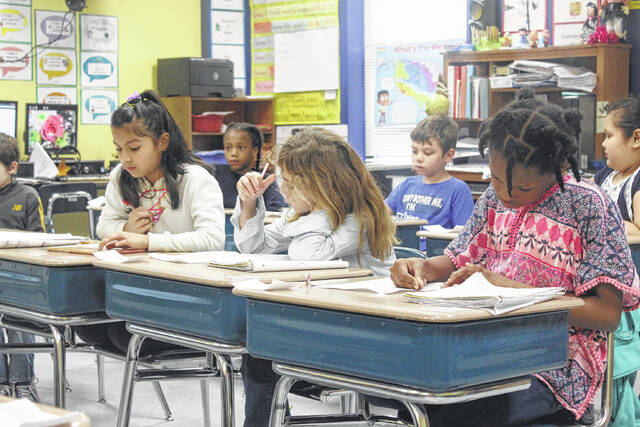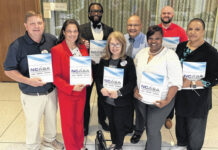
School district officials are proposing an increase in the per pupil allocation from $646.45 to $936.75 — an increase of $290.30 per child.
Robesonian file
LUMBERTON – The Robeson County Board of Education and the county’s Board of Commissioners held a joint meeting on Tuesday evening at the school’s District Office.
In what was a loaded meeting agenda, a couple of big requests and topics were tackled:
“I look forward for our two boards to come together and work together. … We’re here to help and help make Robeson County a better place,” said John Cummings, the chairman of the Robeson County Board of Commissioners.
The high school graduation schedules were released during the two-hour meeting.
Graduating students at Early College High School will receive their diplomas at 10 a.m. on May 17 at Robeson Community College, according to school spokeswoman Jessica Sealey. The county’s other high schools will graduate at 9 a.m. on June 14.
Of note, the St. Pauls High School graduation ceremony will be at 9 a.m. on June 14 at the University of North Carolina at Pembroke.
In other business:
– Erica Setzer, the chief finance officer for Robeson County Schools, made a presentation on the current expense per pupil increase request. The Public Schools of Robeson County is asking the county for an increase in its current expense per pupil.
No action was taken.
The district is requesting an increase in its local per pupil allocation from $646.45 to $936.75. That’s an increase of $290.30 per child, she said.
These funds, the school system stated in its presentation, will be used to support such budget priorities as:
– Unfunded budget mandates – salary and benefit increases;
– Proposed utility cost increases;
– Increased liability and insurance costs;
– Maintain current level of school resource officers due to reduction in PRC 069;
– Continued curriculum and technology supports for 1 to 1
Initiatives;
– Gaps in state funds primarily related to increased compensation
and benefits;
– Maintain recruiting efforts to ensure all classrooms have a
certified teacher (supplement and bonus supports).
The county is divided into 37 public schools, including seven high schools. Approximately 3,000 people work for the school system.
The district has a total enrollment of 20,849 students, which does not include the pre-kindergarten numbers, Setzer reported.
“It’s an increase. We experienced our first increase this year that we had in the last 15 years,” she told members of the two boards.
– Board of Education Attorney Richard Schwartz gave a report on school construction and renovation bond consideration.
If the county school system decides to embark on that, the question arises concerning what would be done with the bond funding.
“… You’ve heard some good news tonight about all the money that has flowed into the county from ESSER funding,” he said. “Some of that can be used for capital projects, construction work in a limited way. And we’ve got a lot of money from the needs-based schools’ capital fund that’s going to the new (Robeson County Career and Technical Education Center).
“But we still have capital needs for the school system. Your school board has a lot of obligations and responsibilities including to provide safe and secure facilities to keep up those facilities that we have. But the school board doesn’t have the money that it can raise on its own. Because the school board doesn’t have the authority to place the full credit on its constituents or raise tax money,” Schwartz said.
So the responsibility for providing those facilities is on the county, he said. And that’s the way it’s laid out in the state constitution.
“And one of the ways to do that is through bonds,” said Schwartz. “I’m here tonight to talk about school bond referendums. …”
Local governments — including the county but not limited to the county — are authorized to borrow money. “A general obligation bond is one of those ways to do that. That’s the most commonly used way to deal with that,” he said.
A general obligation bond is permitted under the N.C. State Constitution and allows a unit of local government to pledge its “full faith and credit” as security on a bond. A school system does not have the authority to pledge its “full faith and credit.”
The pledge must be made by the county, which can borrow money and issue general obligation bonds. To fund the construction of a school, the bond must be approved by the voters of the county.
Financing school facilities is the most commonly used purpose for general obligation bonds.
The state constitution requires that a majority of the qualified voters in whatever county you are dealing with has approved the county extending its full credit, Schwartz said. That approval is going through a bond referendum. And that authorizes you to issue those general obligation bonds.
Those bonds are generally paid back at a very advantageous rate over a long period of time, according to Schwartz.
And that accomplishes a lot of different things, he added.
“Prior to beginning a bond order and referendum process the school system and the county should have mutual planning sessions, and this is right now the first step in whatever mutual planning sessions to figure out the scope of the project. Bonds can be used in a lot of different things,” Schwartz told the board members.
“So the procedure begins with the board of education voting on resolutions to request the bond referendums,” he said. “And that’s an opportunity for the board of education to do a number of things.”
A bond referendum must take place during a special election and may only take place during the following times:
– At the same time as any other state or county general election;
– At the same time as the primary election in any even‑numbered year;
– At the same time as any other election requiring all the precincts in the county to be open;
– At the same time as a municipal general election, if the special election is within the jurisdiction of the municipality only.
The track record, he said, is pretty good.
In fact, he added, the general obligation bonds from all levels of government – this is combined state, county and municipal, as well – from November 2012 through November 2022 “is rather overwhelming.”
School bonds have a lot of support, he said.
The board of education attorney said the Public Schools of Robeson County could advertise a bond referendum that would be proposed for the ballot and how the bonds would be used. That is often done by coalitions put together to support the schools.
“Working on that coalition and putting that coalition together is the key to success with a bond referendum,” Schwartz said. “And there are countless ways to do it and countless examples of how it has been done before. And been very successful.”
Reach Michael Futch by email at [email protected].






